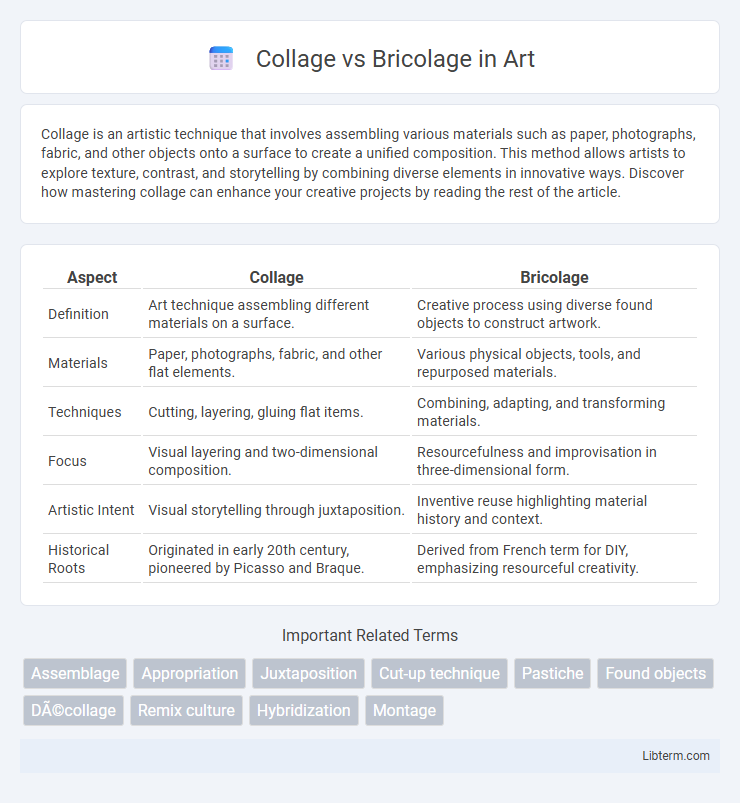Collage is an artistic technique that involves assembling various materials such as paper, photographs, fabric, and other objects onto a surface to create a unified composition. This method allows artists to explore texture, contrast, and storytelling by combining diverse elements in innovative ways. Discover how mastering collage can enhance your creative projects by reading the rest of the article.
Table of Comparison
| Aspect | Collage | Bricolage |
|---|---|---|
| Definition | Art technique assembling different materials on a surface. | Creative process using diverse found objects to construct artwork. |
| Materials | Paper, photographs, fabric, and other flat elements. | Various physical objects, tools, and repurposed materials. |
| Techniques | Cutting, layering, gluing flat items. | Combining, adapting, and transforming materials. |
| Focus | Visual layering and two-dimensional composition. | Resourcefulness and improvisation in three-dimensional form. |
| Artistic Intent | Visual storytelling through juxtaposition. | Inventive reuse highlighting material history and context. |
| Historical Roots | Originated in early 20th century, pioneered by Picasso and Braque. | Derived from French term for DIY, emphasizing resourceful creativity. |
Understanding Collage: Definition and Key Concepts
Collage is an artistic technique that involves assembling various materials such as paper, photographs, fabric, and other found objects to create a new, unified composition. Key concepts include layering, juxtaposition, and the reinterpretation of disparate elements to form innovative visual narratives. This method emphasizes the transformation of everyday items into expressive artworks, highlighting creativity through fragmentation and synthesis.
Bricolage Explained: Origins and Meaning
Bricolage, originating from the French term meaning "DIY" or "making do," refers to creating something new by assembling diverse, available materials or ideas. In contrast to collage, which primarily involves layering images or materials, bricolage emphasizes improvisation and resourcefulness by repurposing objects or concepts in innovative ways. This concept, widely studied in anthropology and cultural theory, highlights adaptive creativity and the inventive reconfiguration of existing elements to produce novel outcomes.
Historical Background of Collage and Bricolage
Collage emerged as an art technique in the early 20th century, pioneered by artists like Pablo Picasso and Georges Braque during the Cubist movement, emphasizing the assembly of diverse paper materials onto a flat surface. Bricolage, rooted in anthropology and popularized by Claude Levi-Strauss in the mid-20th century, describes a creative process of crafting using whatever materials are at hand, reflecting resourcefulness and improvisation. While collage centers on deliberate artistic composition, bricolage extends to broader cultural and social adaptations of assembling disparate elements.
Artistic Techniques in Collage
Collage as an artistic technique involves assembling various materials such as paper, photographs, fabric, and found objects onto a surface to create a unified composition, emphasizing texture and layering. This method allows artists to integrate diverse elements and media, resulting in multidimensional visual narratives that challenge traditional painting and drawing boundaries. Unlike bricolage, which often improvises with available materials in a spontaneous way, collage requires deliberate arrangement and composition to achieve a cohesive aesthetic and conceptual impact.
Bricolage in Practice: Methods and Tools
Bricolage in practice involves using readily available materials and creative problem-solving techniques to construct or repair objects without specialized tools, emphasizing resourcefulness and adaptability. Common methods include repurposing everyday items, improvising with found materials, and combining diverse elements to achieve functional or artistic outcomes. Tools for bricolage range from basic hand tools like scissors and glue to digital platforms that facilitate creative assembly and innovation.
Core Differences Between Collage and Bricolage
Collage combines diverse materials or images into a unified artwork, emphasizing visual composition and aesthetic integration. Bricolage involves constructing or creating from a varied range of available resources, reflecting adaptive problem-solving and resourcefulness. Core differences include collage's focus on artistic assembly versus bricolage's practical reuse and improvisation.
Applications in Contemporary Art and Design
Collage integrates diverse materials and images to create layered, fragmented compositions, widely used in contemporary art for visual storytelling and cultural critique. Bricolage involves assembling found objects and repurposed elements, emphasizing resourcefulness and creative transformation in design practices and installation art. Both techniques challenge traditional aesthetics by promoting hybridity and experimental narratives, enriching visual languages in modern artistic expression.
Collage and Bricolage in Popular Culture
Collage in popular culture involves combining various images, texts, and materials to create new, layered artworks that challenge traditional narratives and aesthetics, often seen in magazine cutouts, digital art, and fashion design. Bricolage, by contrast, repurposes everyday objects and cultural symbols to construct meanings that reflect identity and social commentary, evident in street art and DIY movements. Both techniques subvert conventional forms by embracing fragmentation and reinterpretation, with collage emphasizing visual juxtaposition and bricolage grounded in resourcefulness and cultural hybridity.
Creative Possibilities: Combining Collage and Bricolage
Combining collage and bricolage enhances creative possibilities by merging the strategic layering of diverse images with the resourceful assembly of found objects, resulting in multifaceted artworks that challenge traditional narratives. This fusion encourages experimentation with textures, materials, and symbolic meanings, allowing artists to innovate through juxtaposition and reinterpretation. The integration of collage's visual fragmentation with bricolage's tangible construction creates dynamic compositions that transcend singular mediums and evoke rich, interdisciplinary expressions.
Choosing Between Collage and Bricolage: What to Consider
Choosing between collage and bricolage hinges on the intent and materials involved; collage emphasizes layering diverse media and textures typically on a flat surface, while bricolage utilizes found objects assembled in three-dimensional form. Consider the project's conceptual depth and spatial dynamics, as bricolage often conveys complexity through physical volume and interactivity, whereas collage offers visual diversity through juxtaposition and surface composition. The availability of materials and artistic skillsets also influence the decision, with bricolage requiring more structural assembly and collage favoring manipulation of paper, fabric, or photographic elements.
Collage Infographic

 libterm.com
libterm.com